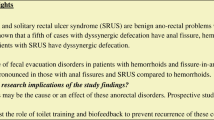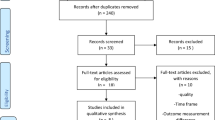Abstract
Nearly all chronic anal fissures occur in the posterior midline of the anal canal. However, some of them are in the anterior midline and are rarely double or in the lateral anal walls. The aim of this study was to determine if the clinical, manometric and endosonographic characteristics in patients with chronic anal fissure varied according to topography of the fissure. The patients included in this prospective study were divided according to a fissure site in posterior midline location (Group A, n = 84) and anterior midline location (Group B, n = 30). No differences were found regarding clinical data except that anterior fissures were more common in females. Mean maximal anal resting pressure and internal anal sphincter thickness was higher in Group A. However, these differences were not statistically significant. We found correlation between mean maximal anal resting pressure and internal anal sphincter thickness in patients suffering from anterior chronic anal fissure.


Similar content being viewed by others
References
Orsay C et al (2004) Practice parameters for the management of anal fissures (revised). Dis Colon Rectum 47(12):2003–2007
Griffin N et al (2004) Quality of life in patients with chronic anal fissure. Colorectal Dis 6(1):39–44
Petros J, Rimm E, Robillard R (1993) Clinical presentation fo chronic anal fissures. Am Surg 59:666–668
Oh C, Divino CM, Steinhagen RM (1995) Anal fissure. 20-year experience. Dis Colon Rectum 38(4):378–382
Casillas S et al (2005) Incontinence after a lateral internal sphincterotomy: are we underestimating it? Dis Colon Rectum 48(6):1193–1199
Nyam DC, Pemberton JH (1999) Long-term results of lateral internal sphincterotomy for chronic anal fissure with particular reference to incidence of fecal incontinence. Dis Colon Rectum 42(10):1306–1310
Schouten WR et al (1996) Anal fissure: new concepts in pathogenesis and treatment. Scand J Gastroenterol Suppl 218:78–81
Arabi Y, Alexander-Williams J, Keighley MR (1977) Anal pressures in hemorrhoids and anal fissure. Am J Surg 134(5):608–610
Gibbons CP, Read N (1986) Anal hypertonia in fissures: cause or effect? Br J Surg, 73:443–445
Lund JN, Scholefield JH (1996) Aetiology and treatment of anal fissure. Br J Surg, 83(10):1335–1344
Bove A et al (2004) Different anal pressure profiles in patients with anal fissure. Tech Coloproctol 8(3):151–156, discussion 156–157
Lindsey I et al (2004) Chronic anal fissure. Br J Surg 91(3):270–279
Nelson R (2004) A systematic review of medical therapy for anal fissure. Dis Colon Rectum 47(4):422–431
Thompson WG et al (1999) Functional bowel disorders and functional abdominal pain. Gut 45(Suppl 2):II43–II47
Farouk R et al (1994) Sustained internal sphincter hypertonia in patients with chronic anal fissure. Dis Colon Rectum 37(5):424–429
Sultan AH et al (1993) Anal endosonography and correlation with in vitro and in vivo anatomy. Br J Surg 80(4):508–511
Nielsen M, Pedersen J, Hauge C, Rasmussen O, Christiansen J (1991) Endosonography of the anal sphicter: findings in healthy volunteers. Am J Roentgenol 157:1199–1202
Gantke B, Schafer A, Enck P, Lubke H (1993) Sonographic, manometric, and myographic evaluation of the anal sphincters morphology and function. Dis Colon Rectum, 36:1037–1041
Papachrysostomou M, Pye S, Wild SR, Smith AN (1993) Anal endosonography in asymptomatic subjects. Scand J Gastroenterol 28:551–556
Schafer R, Heyer T, Gantke B, Schafer A, Frieling T, Haussinger D (1997) Anal endosoography and manometry. Comparison in patients with defecation problems. Dis Colon Rectum 40:293–297
Keck JO et al. (1995) Computer-generated profiles of the anal canal in patients with anal fissure. Dis Colon Rectum 38(1):72–79
Taylor BM, Beart RW Jr, Phillips SF (1984) Longitudinal and radial variations of pressure in the human anal sphincter. Gastroenterology 86(4):693–697
Ciccaglione AF et al (2000) Short- and long-term effect of glyceryl trinitrate (GTN) ointment 0.2% and 2% on anal canal pressure in patients with chronic anal fissures. Dig Dis Sci 45(12):2352–2356
Corby H et al (1997) Anal canal pressures are low in women with postpartum anal fissure. Br J Surg 84(1):86–88
Jones OM et al (2005) Digital rectal examination of sphincter pressures in chronic anal fissure is unreliable. Dis Colon Rectum 48(2):349–352
Jost WH, Schrank B (1999) Repeat botulin toxin injections in anal fissure: in patients with relapse and after insufficient effect of first treatment. Dig Dis Sci 44(8):1588–1589
Klosterhalfen B et al (1989) Topography of the inferior rectal artery: a possible cause of chronic, primary anal fissure. Dis Colon Rectum 32(1):43–52
Lund JN et al (1999) Topographical distribution of blood supply to the anal canal. Br J Surg 86(4):496–498
Pascual M, Courtier R, Gil MJ, Puig S, Serrano A, Andreu M, Pera M, Grande L (2005) Estudio ecográfico y manométrico del esfínter anal interno en individuos con fisura anal crónica. Cirugía Española 77(1):27–30
Marshall M et al (2002) Predictive value of internal anal sphincter thickness for diagnosis of rectal intussusception in patients with solitary rectal ulcer syndrome. Br J Surg 89(10):1281–1285
Acknowledgments
The authors thank Janice Ferrari for his advice regarding linguistic accuracy.
Author information
Authors and Affiliations
Corresponding author
Rights and permissions
About this article
Cite this article
Pascual, M., Parés, D., Pera, M. et al. Variation in Clinical, Manometric and Endosonographic Findings in Anterior Chronic Anal Fissure: A Prospective Study. Dig Dis Sci 53, 21–26 (2008). https://doi.org/10.1007/s10620-007-9816-2
Received:
Accepted:
Published:
Issue Date:
DOI: https://doi.org/10.1007/s10620-007-9816-2




